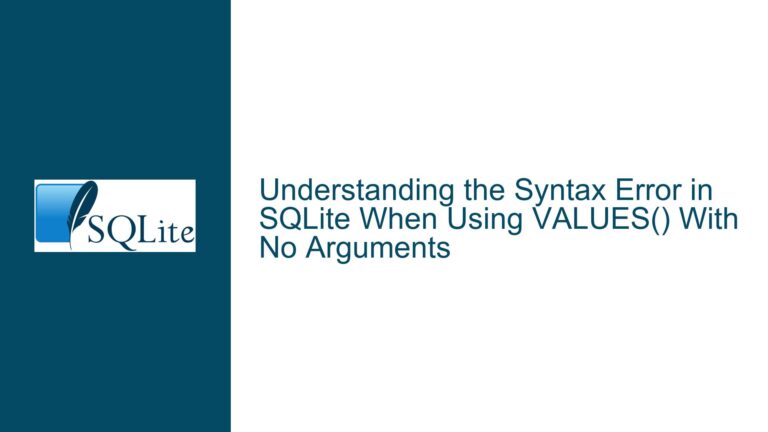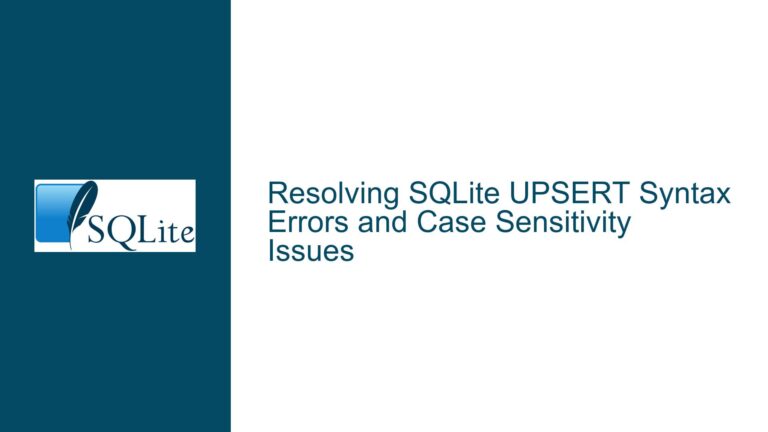SQLite Recursive Query Row Accumulation and Discard Behavior
Issue Overview: Recursive Query Row Accumulation vs. Discard in SQLite
When working with recursive queries in SQLite, particularly in scenarios involving linked lists or hierarchical data structures, understanding how rows are processed during recursion is critical. The core issue revolves around whether rows generated during the recursive steps are accumulated in memory or evaluated and discarded on the fly. This behavior directly impacts query performance, memory usage, and the correctness of the results.
In the provided scenario, a recursive query is used to traverse a linked list structure stored in a table (pt_pointers). Each row in this table contains a data_key, a prev_key, and a next_key, which define the order of the rows. The query aims to traverse the list starting from a specific key (:startKey) and accumulate a calculated value (char_begin) until a breakpoint (:breakPt) is reached. The final results are filtered to include only rows that satisfy a specific condition involving :selStart and :selEnd.
The query plan shows that the recursive portion of the query (pieces) is executed using a combination of SEARCH and SCAN operations, but it does not explicitly indicate whether intermediate rows are materialized or discarded. This ambiguity raises the question: Are all rows generated during recursion stored in memory, or are they evaluated and discarded as soon as they are no longer needed?
Possible Causes: Why Row Accumulation or Discard Behavior Matters
The behavior of row accumulation or discard in recursive queries depends on several factors, including the query plan, the structure of the recursive query, and the underlying database engine’s optimization strategies. Here are the key factors that influence this behavior:
Query Plan and Materialization: SQLite’s query planner decides whether to materialize intermediate results or process them on the fly. Materialization involves storing intermediate results in memory or temporary storage, which can lead to higher memory usage but may improve performance for certain types of queries. In the provided query plan, the absence of a
MATERIALIZEstep suggests that SQLite may be processing rows on the fly, but this is not definitive.Recursive Query Structure: The structure of the recursive query, including the use of
UNION ALLand the presence of aLIMITclause, can influence whether rows are accumulated or discarded. TheUNION ALLoperator ensures that all rows generated during recursion are included in the final result set, but theLIMITclause can prevent infinite recursion and reduce the number of rows processed.Index Usage and Filter Conditions: The efficiency of the recursive query depends on the availability and usage of indexes. In this case, the query uses an index (
pt_pointers_idx_537d0940) to search for rows in thept_pointerstable. However, the filter conditions in the recursive step (WHEREclause) and the final results (resultstable) can impact whether rows are discarded early or retained in memory.Breakpoint and Accumulation Logic: The logic used to calculate the
char_beginvalue and the breakpoint condition (:breakPt) determines how many rows are processed before the recursion stops. If the breakpoint condition is met early, fewer rows will be processed, reducing the likelihood of accumulation.Memory Management in SQLite: SQLite’s memory management strategies, including the use of temporary storage and the handling of large result sets, can influence whether rows are accumulated or discarded. SQLite is designed to be lightweight and efficient, but complex recursive queries can still strain memory resources.
Troubleshooting Steps, Solutions & Fixes: Diagnosing and Optimizing Recursive Query Behavior
To determine whether rows are being accumulated or discarded in the recursive query, and to optimize the query for performance and memory usage, follow these steps:
Analyze the Query Plan in Detail: The query plan provides insights into how SQLite executes the query. Look for operations such as
MATERIALIZE,SCAN, andSEARCHto understand how intermediate results are handled. In the provided query plan, the absence of aMATERIALIZEstep suggests that SQLite may be processing rows on the fly, but this is not conclusive. Use theEXPLAIN QUERY PLANstatement to generate a more detailed query plan and look for additional clues.Test with Smaller Data Sets: Run the query on smaller data sets to observe its behavior. If the query processes fewer rows, it is more likely that rows are being discarded rather than accumulated. Compare the memory usage and execution time for different data set sizes to identify patterns.
Monitor Memory Usage: Use SQLite’s memory monitoring tools to track memory usage during query execution. If memory usage increases significantly as the number of processed rows grows, it is likely that rows are being accumulated. Tools such as
sqlite3_status()can provide detailed memory usage statistics.Optimize Indexes and Filter Conditions: Ensure that the
pt_pointerstable has appropriate indexes to support the recursive query. The existing index (pt_pointers_idx_537d0940) is used for searching, but additional indexes onprev_keyandnext_keymay improve performance. Review the filter conditions in the recursive step and the final results to ensure they are as selective as possible, reducing the number of rows processed.Refactor the Recursive Query: Consider refactoring the recursive query to minimize the number of rows processed. For example, you could add additional breakpoint conditions or use a more efficient algorithm for traversing the linked list. Experiment with different query structures to find the most efficient approach.
Use Temporary Tables: If the recursive query generates a large number of intermediate rows, consider using temporary tables to store intermediate results. This can reduce memory usage by offloading data to disk, but it may also impact performance due to increased I/O operations. Use the
CREATE TEMPORARY TABLEstatement to create temporary tables and insert intermediate results.Limit the Depth of Recursion: The
LIMITclause in the recursive query prevents infinite recursion, but it can also be used to control the depth of recursion. Experiment with different values for:maxKeyto find the optimal balance between performance and memory usage.Profile Query Execution: Use SQLite’s profiling tools to analyze query execution in detail. The
sqlite3_profile()function can be used to measure the time spent on each step of the query, helping you identify bottlenecks and optimize performance.Consider Alternative Approaches: If the recursive query is too complex or inefficient, consider alternative approaches for traversing the linked list. For example, you could use a procedural language (e.g., Python or Java) to implement the traversal logic and interact with SQLite via an API. This approach may provide more control over memory usage and performance.
Review SQLite Documentation and Community Resources: SQLite’s documentation and community forums are valuable resources for understanding recursive query behavior and optimization techniques. Review the documentation on recursive queries, query planning, and memory management to gain a deeper understanding of the underlying mechanisms.
By following these steps, you can diagnose whether rows are being accumulated or discarded in the recursive query, optimize the query for performance and memory usage, and ensure that it produces the correct results. Understanding the nuances of recursive query behavior in SQLite is essential for building efficient and reliable database applications.






